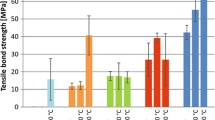Abstract
This study presents an investigation of the adhesion properties of a chromium-gold-titanium layer system, which is used in the LIGA process to create moveable microstructures. The main purpose has been the improvement of the process parameters to increase yield reliability.
Three mechanisms affecting the adhesion have been identified. As a consequence of humidity adsorbed H2O reacts with Al2O3 to AlO(OH) (aluminum meta hydrates), which does not bond to the sputtered chromium layer. Thus the hydrate must be removed by cleaning the surface with Ar+-ions. Tight layers without pores could be realized by optimization pressure and temperature during sputtering of chromium and gold. Thus, diffusion of chromium or penetration of etchants into the gold layer as well as impact or diffusion of titanium into the gold layer could be prevented. In addition, a copper layer was introduced as a further intermediate layer by electroforming to improve the formation of stable nickel alloys at the interface between the sputtered gold and the electroplated nickel.
These measures resulted in an improvement of the adhesion, so that full functional acceleration sensors were produced with a high yield.
Similar content being viewed by others
Author information
Authors and Affiliations
Rights and permissions
About this article
Cite this article
Kunz, T., Mohr, J., Ruzzu, A. et al. Adhesion of Ni-structures on Al2O3 ceramic substrates used for the sacrificial layer technique. Microsystem Technologies 6, 121–125 (2000). https://doi.org/10.1007/s005420050179
Issue Date:
DOI: https://doi.org/10.1007/s005420050179




